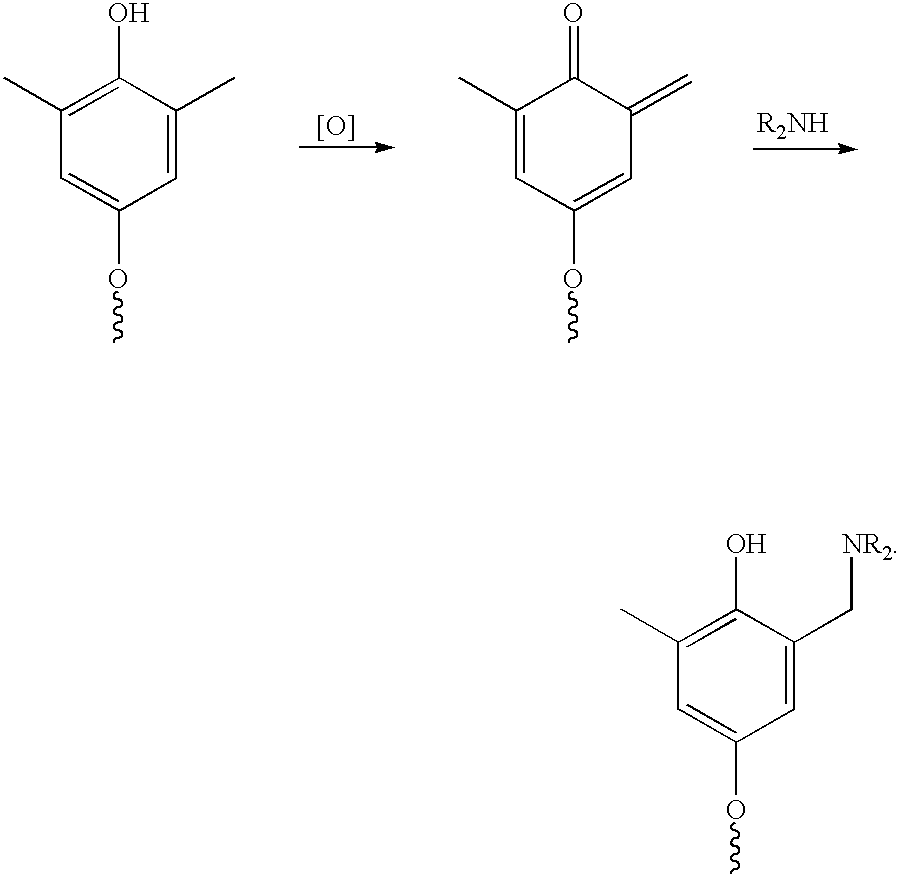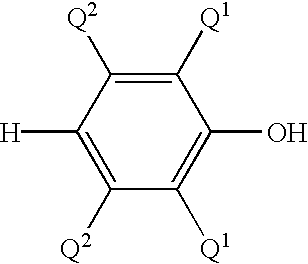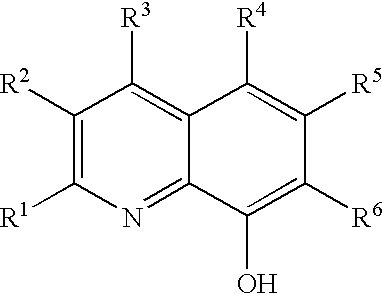Method of preparing a poly (arylene ether) and a poly (arylene ether) prepared thereby
a technology of arylene ether and polymer, which is applied in the direction of dyeing process, textiles and paper, etc., can solve the problems of reactive functional group generation on the polymer, and achieve the effect of improving the mixing and extraction efficiency
- Summary
- Abstract
- Description
- Claims
- Application Information
AI Technical Summary
Problems solved by technology
Method used
Image
Examples
examples 2-26
These examples illustrate the determination of cloud points for toluene solutions of poly(2,6-dimethyl- 1,4-phenylene ether-co-2,3,6-trimethyl-1,4-phenylene ether) as a function of copolymer concentration, copolymer intrinsic viscosity, and copolymer composition. Copolymers having intrinsic viscosities of 35.3 mL / g to 41.6 mL / g, and 15, 18, and 21 weight percent of units derived from 2,3,6-trimethylphenol (TMP) were synthesized according to the procedure of Example 1. For a given copolymer solubility determination, an isolated poly(arylene ether) copolymer was dissolved at 10 to 30 weight percent in toluene at 90.degree. C. The temperature of the solution was decreased at a rate of about 1.degree. C. per minute and the temperature at which the first turbidity was observed was recorded as the cloud point, T.sub.cloud. Results are presented in Table 1.
Using linear regression techniques, the data were used to generate the equation (I):
.phi..sub.s =(0.30.+-.0.15)IV+(1.27.+-.0.31)TMP-(35...
examples 27 and 28
, COMPARATIVE EXAMPLES 1 AND 2
These examples show the effect of reaction temperature versus time on the amount of incorporated amine. All examples and comparative examples were prepared by procedures similar to that detailed in Example 1. Data presented for Example 27 represent an average of 25 pilot plant batches. In Example 27, copolymers were prepared from 82 weight percent 2,6-dimethylphenol and 18 weight percent 2,3,6-trimethylphenol in a 190 liter pilot scale reactor using the reaction temperature profile indicated by a solid line in FIG. 1 and labeled "Ex. 27". As in Example 1, the 2,6-dimethylphenol and 2,3,6-trimethylphenol collectively represented 23.1 weight percent of the total reaction mixture for Example 27. The product copolymer had an intrinsic viscosity of about 0.40 dL / g, a TMP content of about 18 weight percent, and a concentration in the reaction mixture of about 23 weight percent. Using the equation for T.sub.cloud derived in Examples 2-26, the reaction mixture ...
example 28
manufacturing scale (19,000 L reactor) using the temperature profile shown in FIG. 2, which was similar to that used for Example 27 and is significantly higher during the build phase than the temperature profile for Comparative Examples 1 and 2. A poly(arylene ether) copolymer having an intrinsic viscosity of 0.41 dL / g was obtained. Other properties of the copolymer are presented in Table 2. The results are very similar to those for Example 27, indicating that the advantages of the invention can be obtained on both pilot and manufacturing scales. Examples 27 and 28 collectively show that maintaining a reaction temperature above the cloud point temperature of the reaction mixture enables the production of a poly (arylene ether) having a high amine content.
PUM
| Property | Measurement | Unit |
|---|---|---|
| weight ratio | aaaaa | aaaaa |
| temperature | aaaaa | aaaaa |
| weight percent | aaaaa | aaaaa |
Abstract
Description
Claims
Application Information
 Login to View More
Login to View More - R&D
- Intellectual Property
- Life Sciences
- Materials
- Tech Scout
- Unparalleled Data Quality
- Higher Quality Content
- 60% Fewer Hallucinations
Browse by: Latest US Patents, China's latest patents, Technical Efficacy Thesaurus, Application Domain, Technology Topic, Popular Technical Reports.
© 2025 PatSnap. All rights reserved.Legal|Privacy policy|Modern Slavery Act Transparency Statement|Sitemap|About US| Contact US: help@patsnap.com



